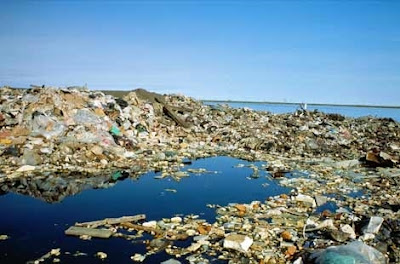More and more in this society we have become more dependent on packaging for everything; specifically plastic packaging. Products that used to be packaged in glass containers or tin cans now come in plastic bottles or jars, as do products that used to come in paper or cardboard containers. As a result of the recent packaging habits, we use more plastic container each day then we did ever before. Roughly 300 million tons will be produced worldwide next year (Plastic Not so Fantastic). The amount of plastic manufactured in the first ten years of this century will approach the total produced in the entire last century.While it is a quick and easy and can be used virtually anywhere, plastic is not always that option. Besides being so versatile, plastic is leaving behind a growing trail of waste. Plastic production outstrips plastic recycling by six to one (Negative Effects of Packaging).
 |
| Pacific Ocean Trash Vortex |
If we step back now to look at the recycling process of plastics and where they usually end up, the answer usually is the garbage. Plastic is not an easy material to recycle. Producing plastic as well as recycling it deals with many nasty chemicals that are not good for human health. Plastic, produced from natural gas, is chemically altered by plasticizers during production to increase resilience. Unfortunately these plasticizers tend to vaporize during the process presenting a health risk. This is not the only risk, "diethylhexyl phthalate is cancer inducing, while other additives interfere with the human endocrine system and suppress the immune system, also leading to cancer and causing birth defects, according to planetthoughts.org, an environmental watchdog website. Toxic emissions into both the air and water are common at plastic production plants"(Negative Effects of Packaging). After production, plastics have a very short user life. Only a small portion of plastic is 'recycled' and often this is sold to other countries with more lenient protocols. Often un-recycled plastic ends up in floating trash islands in the ocean. While it is semi well known, the magnitude of the Pacific Trash Vortex still surprises people (two times larger then the size of Texas). The amount of toxic chemical that are leaking into the ocean from this large garbage pile has not even been fully understood. The local wildlife has been greatly affected. Bird carcases are found filled with plastic and garbage that the animal tried to eat as food. A quick image search on Google.com may show a picture of a turtle eating a plastic bag or other animals being affected by the horrible amount of trash humans (especially Americans) produce.
 |
| 'Garbage Island' floating on the Pacific Ocean |
Comparing the recycling of plastic with glass is an interesting view. While 36% plastic is recycled compared to 22% of glass containers, plastic takes up 1/4 of garbage being added to landfills by volume (Glass V.s Plastic Containers)! This is much larger then it seems as plastic is usually thin and crush-able. Glass garbage only makes up 2% by volume of all garbage going to landfills (and glass is very dense and usually thick). For both products, making recycled products uses less energy then when starting with virgin material, but we (human populations) can't seem to get the plastic in the recycling bin.
Making recycled glass containers actually uses 35% less energy then making the original product. Producers do have to worry about impurities though. While plastic containers are primarily used for their low density and durability, plastic is created from oil which is non-renewable. Sadly plastic can't be recycled forever; eventually it will result in a brittle product if it is recycled too many times. Glass has the benefit of being able to be recycled over and over without losing quality in the finished product (Plastic Not so Fantastic).
Chemical Migration from Plastic to Humans and the Environment
According to the International Plastics Task Force, harmful chemicals -- such as acetaldehyde -- can migrate from plastic packaging to the contents of the package (or to soil and water in the landfills they sit in). There are many plastics that have such harmful chemicals including polystyrene, PVC and polyethylene.
Chemicals that are added to plastics to increase durability and to produce the flexible qualities are absorbed by human bodies. These non-naturally occurring chemicals have been found to alter hormones and produce adverse human health effects. Plastic buried deep in landfills can leach harmful chemicals that spread into groundwater coming around to effect hose living close by. An example, bisphenol A (BPA), found in polycarbonate bottles and the linings of food and beverage cans, can leach into food and drinks. The U.S. Centers for Disease Control and Prevention reported that 93 percent of people had detectable levels of BPA in their urine (Plastic Not so Fantastic). The report noted that the high exposure of premature infants in neonatal intensive care units to both BPA and phthalates is of “great concern.” BPA is known to create reproductive problems and highest exposures can lead to heart disease and diabetes.
Just think for a bit the next time you are grocery shopping, buying a plastic water bottle, or heating something plastic up in the microwave. Chemical that are leeching into your food/liquids and then once you dispose of them, into the environment to effect you again through the circle of life.
Be Environmentally Aware. Think Recycling. Pick Glass.
- Marshelle
No comments:
Post a Comment